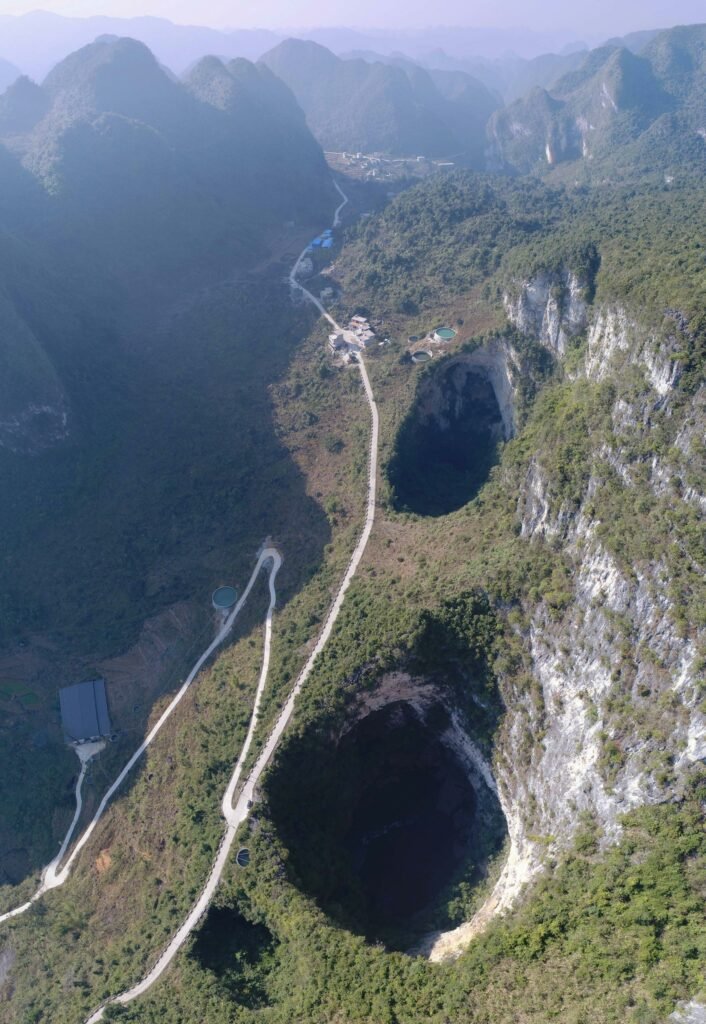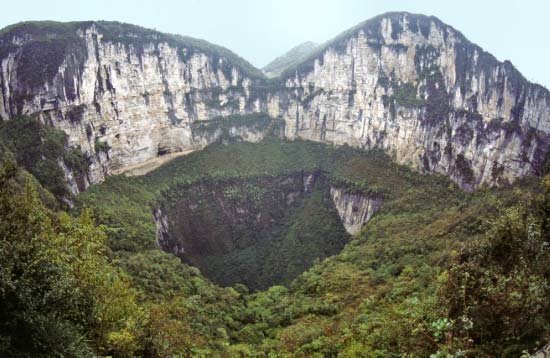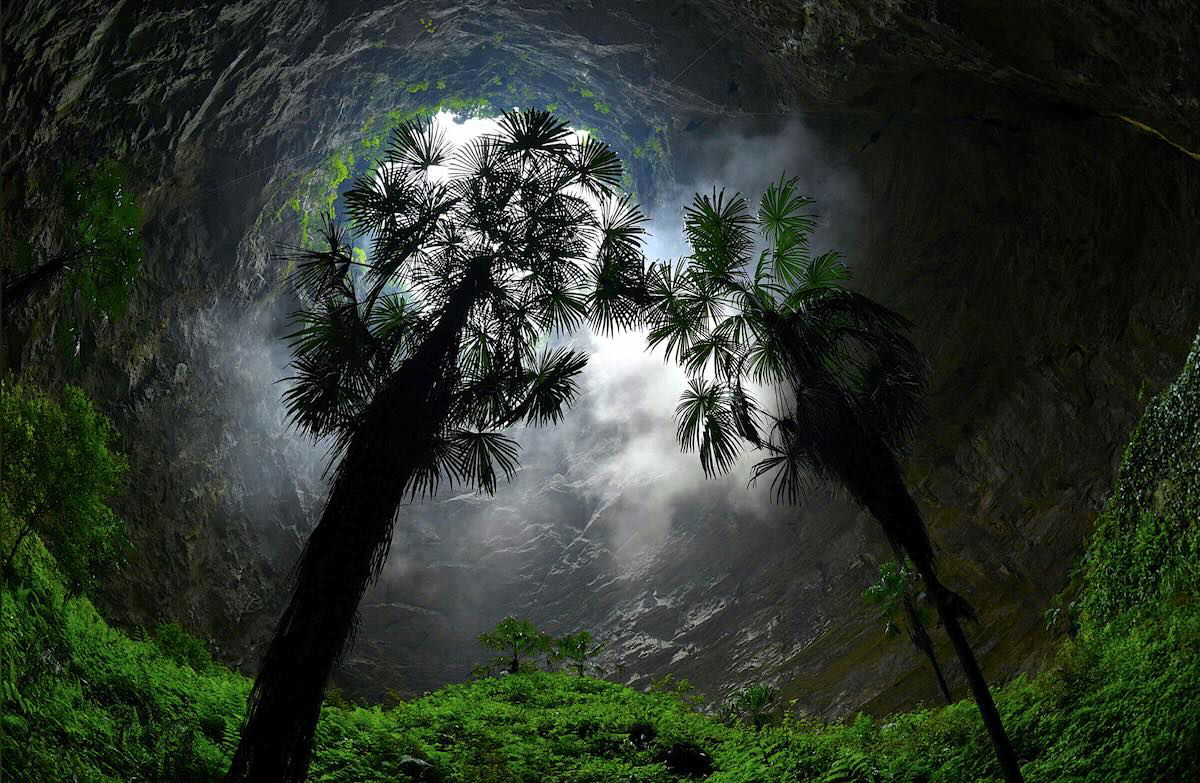In the heart of China’s karst landscapes, the recent discovery of massive sinkholes that contain ancient forests play a vital role in biodiversity conservation, and seem to be teeming with life. The karst tiankengs are refuges for genetic diversity, particularly for endangered species like Manglietia aromatica. A new study published the March 2024 issue of the journal Forests provides compelling evidence of these sinkholes’ significance in the conservation of long lost DNA.
Karst tiankengs are colossal sinkholes formed by the dissolution of soluble rocks such as limestone, which is prevalent in regions like Guangxi, China. These geological formations are not just spectacular natural wonders; they are also ecological hotspots.
Peering down into these giant holes in the Earth, one is greeted not with a desolate rocky cave, but a hidden lush green forest.
“The scene down there was stunning: an underground pristine forest with no trace of human activities, with 40 meter-high ancient trees and a group of endangered wild plants from the times of dinosaurs,” explained Tang Jianmin, an associate Researcher at Guangxi Institute of Botany, in an article.
The process begins when water acidified by carbon dioxide seeps into the soil, slowly dissolving the underlying limestone. Over time, this leads to the creation of underground voids that eventually collapse, forming tiankengs, which is Mandarin for “heavenly pits.”
With 300 known tiankengs in the world, 200 of which are in China, scientists have been studying the various plants and animals that reside there.


This most recent study conducted by a team of researchers, including Tang Jianmin, from the Guangxi Institute of Botany, utilized advanced Hyper-seq gene sequencing technology to analyze the genetic diversity of Manglietia aromatica, a rare tree species. Sheltered for milenia, this tree thrives in these deep sinkholes, and has avoided the near extinct fate of its surface living brethren.
According to the study, the genetic diversity within the tiankeng populations of Manglietia aromatica is significantly higher than those found outside these sinkholes. Specifically, the genetic diversity index (π) was 0.2044 for populations within the tiankengs, compared to 0.1671 for those outside. The Chinese scientists suggest that tiankengs may act as natural conservatories, preserving a rich genetic pool that enhances species resilience and adaptability.
Moreover, the study revealed moderate genetic differentiation between populations inside and outside the tiankengs. This moderate differentiation underscores the partial genetic isolation provided by tiankengs, which likely contributes to the unique genetic traits observed within these populations. In really simple terms, life inside these underground forests evolved differently, and if this is the case for Maglietia aromatica, what does this say for all the other species of plants and animals that live there?
“By revealing the plant’s mating system patterns and spatial variation rules, its evolutionary history and the changes in its geographical distribution in response to climate and geological environment changes, our study provides a scientific basis for effective protection,” Jianmin stated.


(Image: Tony Waltham)
The unique microclimates and isolated environments within tiankengs foster the development of diverse ecosystems relatively untouched by human activity. The forests within tiankengs are more than just collections of trees; they are dynamic environments that support complex food webs and ecological interactions. The genetic diversity found in these forests contributes to the overall health and stability of the ecosystem, enabling plants and animals to adapt to changes and resist diseases. Furthermore, these forests play a crucial role in carbon sequestration, helping to mitigate climate change by absorbing carbon dioxide from the atmosphere.
“I wouldn’t be surprised to know that there are species found in these caves that have never been reported or described by science until now,” George Veni, executive director of the National Cave and Karst Research Institute in New Mexico, told AccuWeather two years ago after the discovery of a 192 meter deep tiankeng in Leye, a county in China’s Guangxi region. With nearly 5 million cubic meters of volume, this is one giant underground cave, filled with massive ancient trees, and countless animals.
The Leye county tiankeng alone supports a diverse array of species, from flying squirrels and civets, to an assortment of reptiles and amphibians, including various snakes, frogs, and lizards. The caves within these tiankengs are crucial habitats for numerous bat species and the underground rivers weaving through these tiankengs are home to many unknown cave fish. One particular species is a ghostly white, blind species, some adorned with peculiar head protrusions, adapted to the dark, isolated aquatic environments.
However, the exclusivity of this habitat makes them particularly susceptible to extinction, with several species already listed as endangered or vulnerable.
The discovery and subsequent studies of China’s karst tiankengs have opened a new chapter in our understanding of conservation biology and the importance of natural refuges in preserving genetic diversity. This most recent study proves that these giant underground forests not only house some of the last remaining members of certain plant and animal species but also genetic variations that have ceased to exist on the surface.
“You don’t know what you’re going to find in each corner, and sometimes we are surprised and occasionally something breaks through our own expectations,” Veni stated back in 2022. “It’s interesting that we’ve gone from living in caves to now studying and exploring them.”
MJ Banias covers space, security, and technology with The Debrief. You can email him at mj@thedebrief.org or follow him on Twitter @mjbanias.

